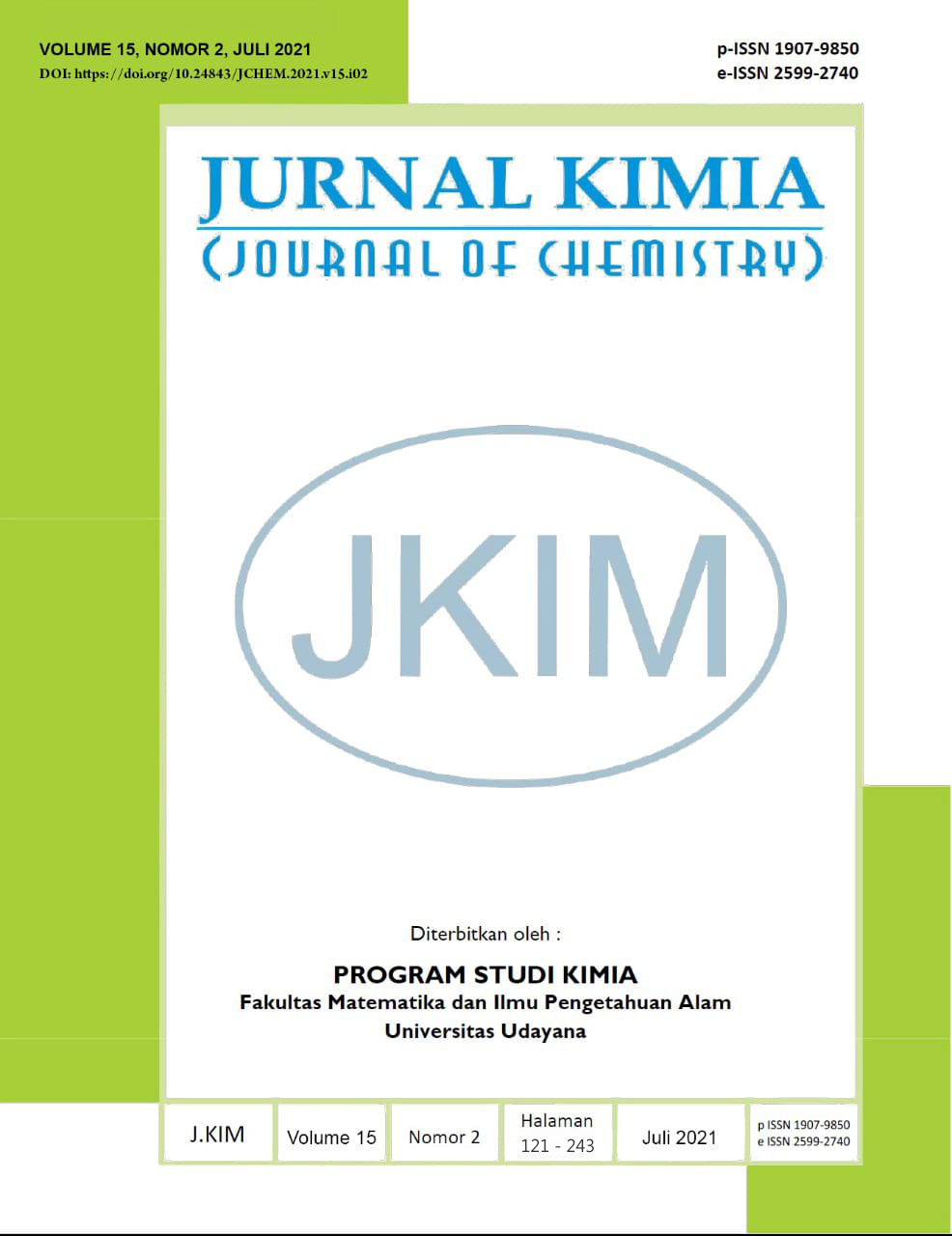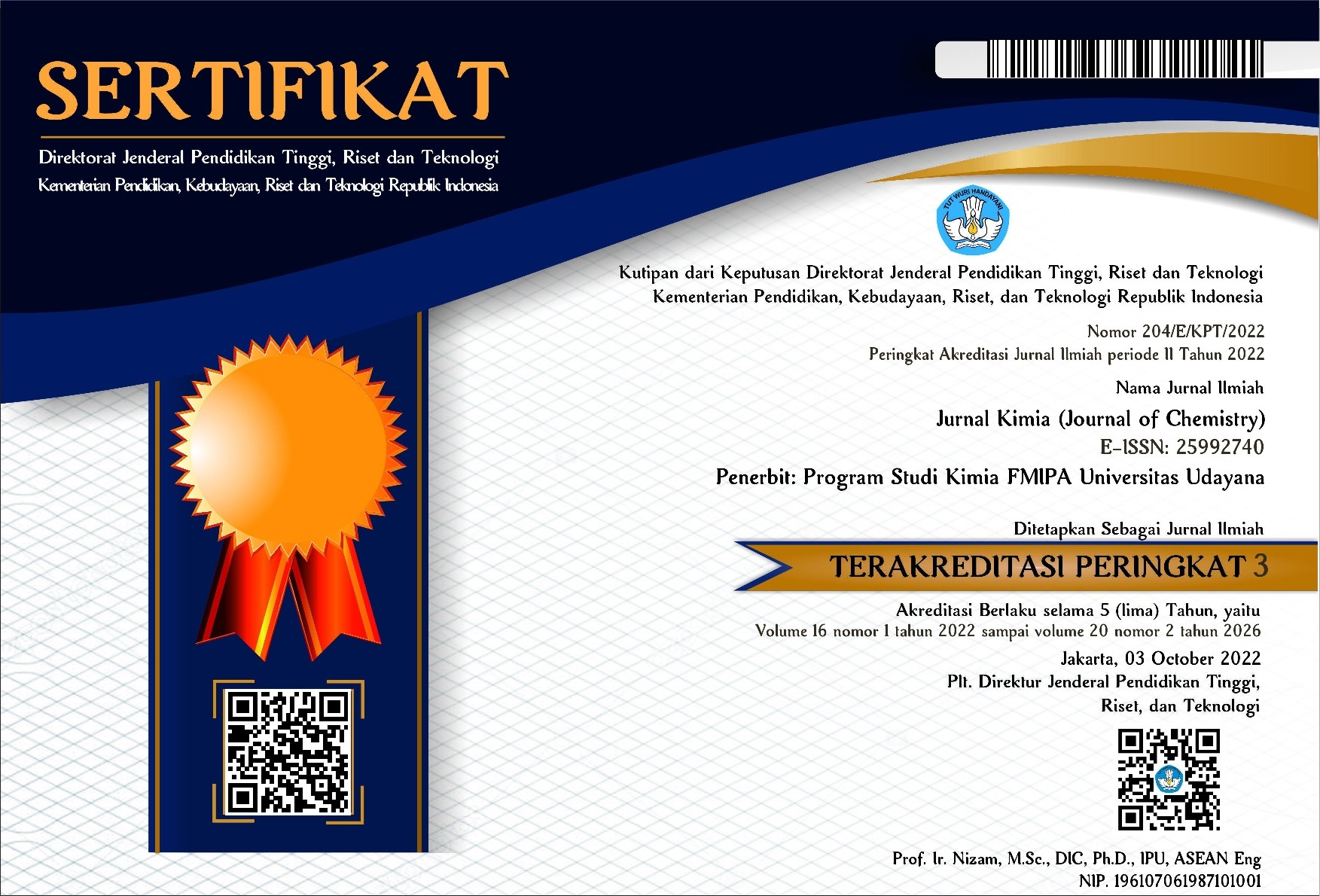PENGARUH WAKTU POLIMERISASI TERHADAP KARAKTERISTIK KOMPOSIT POLIPIROL/KARBON AKTIF (PPy/KA) DARI TEMPURUNG KELAPA SEBAGAI ELEKTRODA SUPERKAPASITOR
Abstract
Komposit polipirol/karbon aktif tempurung kelapa (PPy/KA) telah berhasil disintesis dengan menggunakan metode polimerisasi in-situ. Penelitian ini bertujuan untuk mengetahui pengaruh lamanya waktu polimerisasi terhadap konduktivitas dan kapasitansi dari komposit PPy/KA. Tempurung kelapa dikarbonisasi pada suhu 250oC selama 2 jam dan diaktivasi dengan KOH 50%. Waktu polimerisasi yang digunakan pada sintesis PPy/KA yaitu 2 jam, 4 jam, 6 jam, dan 24 jam. Hasil karakterisasi menunjukkan karbon aktif tempurung kelapa yang diperoleh memenuhi syarat SNI 06-3730-1995. Hasil karakterisasi dari FTIR menunjukkan terjadi pergeseran serapan vibrasi ulur N-H pada 3433,29 cm-1, vibrasi ulur C=C pada 1558,48 cm-1 dan C-H out of plane pada 933,55 cm-1 pada PPy, menjadi 3448,72 cm-1; 1566,48 cm-1 dan 925,83 cm-1 pada komposit PPy/KA. Pergeseran serapan ini menunjukkan adanya interaksi antara PPy dengan karbon aktif. Dari data hasil pengukuran dengan LCR-meter dan multimeter menunjukkan bahwa nilai kapasitansi dan konduktivitas terbaik diperoleh pada komposit PPy/KA variasi 4 jam yaitu nilai tegangan sebesar 0,535 V, nilai kapasitansi sebesar 59,17 dengan waktu pengisian selama 200 detik dan waktu pelepasan selama 1994 detik.
Kata Kunci: karbon aktif, komposit PPy/KA, polipirol, waktu polimerisasi.
Composite of polypyrrole/ coconut shell activated carbon (PPy/ KA) has been successfully synthesized by in-situ polymerization method. The aim of this research was to determine the effect of polymerization time on the conductivity and capacitance of PPy / KA composites. The coconut shell was carbonized at 250oC for 2 hours and activated with 50% KOH. The polymerization time for PPy/KA synthesis was 2 hours, 4 hours, 6 hours, and 24 hours. The characterization results of the coconut shell activated carbon have met the national standard of SNI 06-3730-1995. The results from FTIR characterization showed that there was a shift in the absorption vibration of N-H stretching at 3433,29 cm-1, C=C stretching at 1558,48 cm-1 and C-H out of plane at 933,55 cm-1 for PPy, shifted to 3448,72 cm-1; 1566,48 cm-1 and 925,83 cm-1 for PPy/KA composite. This indicated that there were interaction between KA and PPy. From the data measurement using LCR-meter and multimeter showed that the best capacitance and conductivity values ??were obtained in the 4-hour variation PPy / KA composites. Voltage and capacitance measurement showed 0.535 V and 59.17 ?F, respectively, with a charging time of 200 seconds and discharging time of 1994 seconds.
Keywords: activated carbon, polymerization time, polypyrrole, PPy/KA composite.
Downloads
References
Balli, B., Şavk, A., dan Şen, F. 2019. Graphene and polymer composites for supercapacitor applications. Nanocarbon and Its Composite: Preparation, Properties and Applications. Woodhead Publishing Series in Composites Science and Engineering. 123-151.
Chitte, H. K., Bhat, N. V., Walunj, V. E., dan Shinde, G.N. 2011. Synthesis of Polypyrrole Using Ferric Chloride (FeCl3) as Oxidant Together with Some Dopants for Use in Gas Sensors. Journal of Sensor Technology. 1: 47-56.
Chougule, M. A., Pawar, S. G., Godse, P. R., Mulik, R .N., Sen, S., dan Patil, V. B. 2011. Synthesis and Characterization of Polypyrrole (PPy) Thin Films. Soft Nanoscience Letters. 1: 6-10.
Erlina, Umiatin, dan Budi, E. 2015. Pengaruh Konsetrasi Larutan KOH Pada Karbon Aktif Tempurung Kelapa Untuk Adsorpsi Cu. Prosiding Seminar Nasional Fisika. 4: VII-55 – VII-60.
Huang,Y., Hong, F. L., Wang, Z. F., Zhu, M. S., Pei, Z. X., Xue, Q., Huang, Y., dan Zhi, C.Y. 2016. Nanostructured Polypyrrole as a flexible electrode material of supercapacitor. Nano Energy. 22: 422-438.
Kujundziski, A. P., Chamovcska, D., dan Grchev, T. 2014. Capacitive Properties of Polypyrrole/Activated Carbon Composite. Hemijska Industrija. 68(6): 709-719.
Le, T. H., Kim, Y. K., dan Yoon, H. S. 2017. Electrical and Electrochemical Properties of Conducting Polymers. Polymers. 9(4): 150.
Li, S., Qian, K. K., wang, S., Liang K. Q., dan Yan, W. 2017. Polypyrrole-Grafted Coconut Shell Biological Carbon as a Potential Adsorbent for Methyl Tert-Butyl Ether Removal: Cahracterization and Adsorption Capability. Int. J. Environ. Res. Public Health. 14: 113.
Liu, Y., Wang, H. H., Zhou, J., Bian, L. Y., Zhu, E.W., dan Hai, J.F. 2013. Graphene/polypyrrole Intercalating Nanocomposites as Supercapacitros Electrode. Electrochimica Acta. 112: 44-52.
Nurdiati, D. 2015. Sintesis Komposit PANI/Karbon Dari Tempurung Kemiri (Aleurites moluccana) Sebagai Elektroda Kapasitor. Jurnal Fisika Unand. 4(1): 51-57.
Prasetyo, A., Yudi, A., dan Astuti, N. 2011. Adsorpsi Metiloen Blue Pada Karbon Aktif Dari Ban Bekas Dengan Variasi Konsentrasi NaCl Pada Suhu Pengaktifan 600oC dan 650 oC. Journal Neutrino. 4 (1): 16-23.
Porciúncula, C. B., Marcilio, N. R., Tessaro, I. C., dan Gerchmann, M. 2012. Production of Hydrogen in the Reaction Between Aluminum and Water in the Presence of NaOH and KOH. Braz. J. Chem. Eng. 29 (2): 337 – 348.
Sasso, C., Beneventi, D., Zeno, E., Chaussy, D., Conil, M.P., dan Belgaceum, N. 2011. Polypyrrole and Polypyrrole/Wood-Derived Material Conducting Composite. BioResources. 6(3): 3585-3620.
Saville, P. 2005. Polypyrrole Formation and Use. Defence R&D Canada. Atlantic.
Setyoningrum, T. M., Setiawan, A., dan Pamungkas, G. 2018. Pembuatan Karbon Aktif dari Hasil Pirolisis Ban Bekas. Eksergi. 15 (2): 54-58.
Sun, H., Cannon, F. S., He, X. 2019.Polypyrrole-Tailored Activated Carbon for Trifluoroacetate Removal from Groundwater. Environ. Eng. Sci. 36 (11): 0453.
Taer, E., Mustika, W. S., Agustino, Fajarini, Hidayu, N., Taslim, R. 2017. The Felxible Carbon Activated Electrodes Made From Coconut Shell Waste for Supercapacitor Application. IOP Conf. Ser.: Earth Environ. Sci. 58: 012065
Thakur, A. K., Choudary, R. B., Majumder, M., Gupta, G. 2017. In-Situ Integration of Waste Coconut Shell Derived Activated Carbon/ Polypyrrole/Rare Earth Metal Oxide (Eu2O3): A Novel Step Towards Ultrahigh Volumetric Capacitance. Electrochimica Acta. 251: 532-545.
Turangan, T. M. B., Tiwow, V. A., dan Simandjuntak, S. 2017. Coconut Shellwaste Pyrolysis Potency as a Carbon Material From Minahasa Charcoal, Indonesia. Int. J. of Appl. Chem. 13(3): 721-731.
Wan, M. X. 2009. Conducting Polymer with Micro or Nanometer Structure. Tshinghua University Press. Beijing.
Wang, J. P., Li, X., Du, X. F., Wang, J., Ma, H.R., dan Jing. X. L. 2017. Polypyrrole Composite with Carbon Material for Supercapacitor. Chemical Papers. 71: 293–316.
Yuliusman. 2016. Pembuatan Karbon Aktif Dari Tempurung Kelapa Melalui Proses Aktivasi Kimia Dengan KOH dan Fisika Dengan CO2. Prosiding Seminar Nasional Teknik Kimia Soebardjo Brotohardjono. 12: B.1-1 – B.1-6.

This work is licensed under a Creative Commons Attribution 4.0 International License






